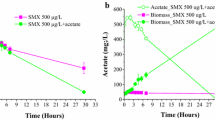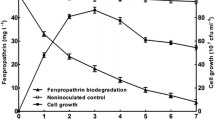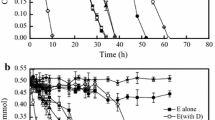Abstract
The current study illustrates the growth kinetics of an efficient PAH and heterocyclic PAH degrading bacterial strain, Pseudomonas aeruginosa RS1 on fluorene (FLU) and dibenzothiophene (DBT) over the concentration 25–500 mg L−1 and their concomitant degradation kinetics. The specific growth rate (µ) was found to lie within the range of 0.32–0.57 day−1 for FLU and 0.24–0.45 day−1 for DBT. The specific substrate utilization rate (q) of FLU and DBT over the log growth phase was between 0.01 and 0.14 mg FLU mg VSS−1 day−1 for FLU and between 0.01 and 0.18 mg DBT mg VSS−1 day−1 for DBT, respectively. The µ and q values varied within a narrow range for both FLU and DBT and they did not follow any specific trend. Dissolution together with direct interfacial uptake was the possible uptake mechanism for both FLU and DBT. The q values over the log growth phase depicts the specific substrate transformation rates. Kirby-Bauer disc diffusion studies performed using an E. coli strain indicated accumulation of some toxic intermediates of FLU and DBT during their degradation. Decrease in TOC and toxicity towards the end of the degradation experiments indicates further utilization of the intermediates.




Similar content being viewed by others
References
Aranda E, Godoy P, Reina R, Badia-Fabregat M, Rosell M, Marco-Urrea E, García-Romera I (2017) Isolation of Ascomycota fungi with capability to transform PAHs: insights into the biodegradation mechanisms of Penicillium oxalicum. Int Biodeterior Biodegrad 122:141–150
Borah D, Agarwal K, Khataniar A, Konwar D, Gogoi SB, Kallel M (2019) A newly isolated strain of Serratia sp. from an oil spillage site of Assam shows excellent bioremediation potential. 3 Biotech 9:1–12
Chakraborty S, Mukherji S, Mukherji S (2010) Surface hydrophobicity of petroleum hydrocarbon degrading Burkholderia strains and their interactions with NAPLs and surfaces. Colloids Surf B Biointerfaces 78:101–108. https://doi.org/10.1016/j.colsurfb.2010.02.019
Dasgupta D, Jasmine J, Mukherji S (2018) Characterization, phylogenetic distribution and evolutionary trajectories of diverse hydrocarbon degrading microorganisms isolated from refinery sludge. 3 Biotech 8:1–18
Desai AM, Autenrieth RL, Dimitriou-Christidis P, McDonald TJ (2008) Biodegradation kinetics of select polycyclic aromatic hydrocarbon (PAH) mixtures by Sphingomonas paucimobilis EPA505. Biodegradation 19:223–233. https://doi.org/10.1007/s10532-007-9129-3
Desta M, Wang W, Zhang L, Xu P, Tang H (2019) Isolation, characterization, and genomic analysis of Pseudomonas sp. strain SMT-1, an efficient fluorene-degrading bacterium. Evol Bioinform 15:1176934319843518
Ghosh P, Mukherji S (2018) Optimization of media composition for enhancing carbazole degradation by Pseudomonas aeruginosa RS1. J Environ Chem Eng 6:2881–2891. https://doi.org/10.1016/j.jece.2018.04.043
Ghosh P, Mukherji S (2020a) Modeling growth kinetics and carbazole degradation kinetics of a Pseudomonas aeruginosa strain isolated from refinery sludge and uptake considerations during growth on carbazole. Sci Total Environ 738:140277
Ghosh P, Mukherji S (2020b) Degradation of carbazole, fluorene, dibenzothiophene and their mixture by P. aeruginosa RS1 in petroleum refinery wastewater. J Water Process Eng 37:101454
Ghosh I, Jasmine J, Mukherji S (2014) Biodegradation of pyrene by a Pseudomonas aeruginosa strain RS1 isolated from refinery sludge. Bioresour Technol 166:548–558. https://doi.org/10.1016/j.biortech.2014.05.074
Grifoll M, Selifonov SA, Chapman PJ (1995) Transformation of substituted fluorenes and fluorene analogs by Pseudomonas sp. strain F274. Appl Environ Microbiol 61:3490–3493
Jamal MT, Pugazhendi A (2018) Degradation of petroleum hydrocarbons and treatment of refinery wastewater under saline condition by a halophilic bacterial consortium enriched from marine environment (Red Sea), Jeddah, Saudi Arabia. 3 Biotech 8:1–10
Jasmine J (2016) Evaluation of bioaugmentation and biostimulation approaches in the treatment of refinery oily sludge. PhD Thesis, CESE,. IIT Bombay
Jasmine J, Mukherji S (2015) Characterization of oily sludge from a refinery and biodegradability assessment using various hydrocarbon degrading strains and reconstituted consortia. J Environ Manag 149:118–125. https://doi.org/10.1016/j.jenvman.2014.10.007
Kirimura K, Harada K, Iwasawa H, Tanaka T, Iwasaki Y, Furuya T, Ishii Y, Kino K (2004) Identification and functional analysis of the genes encoding dibenzothiophene-desulfurizing enzymes from thermophilic bacteria. Appl Microbiol Biotechnol 65:703–713
Kumar M, León V, De Sisto Materano A, Ilzins OA, Luis L (2008) Biosurfactant production and hydrocarbon-degradation by halotolerant and thermotolerant Pseudomonas sp. World J Microbiol Biotechnol 24:1047–1057. https://doi.org/10.1007/s11274-007-9574-5
Li L, Shen X, Zhao C, Liu Q, Liu X, Wu Y (2019) Biodegradation of dibenzothiophene by efficient Pseudomonas sp. LKY-5 with the production of a biosurfactant. Ecotoxicol Environ Saf 176:50–57
Loh KC, Yu YG (2000) Kinetics of carbazole degradation by Pseudomonas putida in presence of sodium salicylate. Water Res 34:4131–4138. https://doi.org/10.1016/S0043-1354(00)00174-3
Marzona M, Pessione E, Di Martino S, Giunta C (1997) Benzothiophene and dibenzothiophene as the sole sulfur source in Acinetobacter: growth kinetics and oxidation products. Fuel Process Technol 52:199–205
Medić A, Lješević M, Inui H, Beškoski V, Kojić I, Stojanović K, Karadžić I (2020) Efficient biodegradation of petroleum n-alkanes and polycyclic aromatic hydrocarbons by polyextremophilic Pseudomonas aeruginosa san ai with multidegradative capacity. RSC Adv 10:14060–14070
Mishra S, Pradhan N, Panda S, Akcil A (2016) Biodegradation of dibenzothiophene and its application in the production of clean coal. Fuel Process Technol 152:325–342. https://doi.org/10.1016/j.fuproc.2016.06.025
Mojiri A, Zhou JL, Ohashi A, Ozaki N, Kindaichi T (2019) Comprehensive review of polycyclic aromatic hydrocarbons in water sources, their effects and treatments. Sci Total Environ. https://doi.org/10.1016/j.scitotenv.2019.133971
Nadalig T, Raymond N, Ni’matuzahroh Â, Gilewicz M, Budzinski H, Bertrand J (2002) Degradation of phenanthrene, methylphenanthrenes and dibenzothiophene by a Sphingomonasstrain 2mpII. Appl Microbiol Biotechnol. 59:79–85. https://doi.org/10.1007/s00253-002-0960-5
Papizadeh M, Ardakani MR, Motamedi H, Rasouli I, Zarei M (2011) C-S targeted biodegradation of dibenzothiophene by Stenotrophomonas sp. NISOC-04. Appl Biochem Biotechnol 165:938–948. https://doi.org/10.1007/s12010-011-9310-3
Ping L, Guo Q, Chen X, Yuan X, Zhang C, Zhao H (2017) Biodegradation of pyrene and benzo [a] pyrene in the liquid matrix and soil by a newly identified Raoultella planticola. 3 Biotech 7:56
Rabodonirina S, Rasolomampianina R, Krier F, Drider D, Merhaby D, Net S, Ouddane B (2019) Degradation of fluorene and phenanthrene in PAHs-contaminated soil using Pseudomonas and Bacillus strains isolated from oil spill sites. J Environ Manag 232:1–7
Ramsauer B, Sterz K, Hagedorn HW, Engl J, Scherer G, McEwan M, Errington G, Shepperd J, Cheung F (2011) A liquid chromatography/tandem mass spectrometry (LC-MS/MS) method for the determination of phenolic polycyclic aromatic hydrocarbons (OH-PAH) in urine of non-smokers and smokers. Anal Bioanal Chem 399:877–889
Rodrigues AC, Wuertz S, Brito AG, Melo LF (2005) Fluorene and phenanthrene uptake by Pseudomonas putida ATCC 17514: kinetics and physiological aspects. Biotechnol Bioeng 90:281–289. https://doi.org/10.1002/bit.20377
Salam LB, Ilori MO, Amund OO (2017) Properties, environmental fate and biodegradation of carbazole. 3 Biotech 7:1–14
Schuler L, Chadhain SMN, Jouanneau Y, Meyer C, Zylstra GJ, Hols P, Agathos SN (2008) Characterization of a novel angular dioxygenase from fluorene-degrading Sphingomonas sp. strain LB126. Appl Environ Microbiol 74:1050–1057
Seo JS (2012) Multiple pathways in the degradation of dibenzothiophene by Mycobacterium aromativorans strain JS19b1 T. J Korean Soc Appl Biol Chem 55:613–618
Shi S, Qu Y, Ma Q, Zhang XW, Zhou J, Ma F (2015) Performance and microbial community dynamics in bioaugmented aerated filter reactor treating with coking wastewater. Bioresour Technol 190:159–166. https://doi.org/10.1016/j.biortech.2015.04.075
Song R, Hua Z, Li H, Chen J (2006) Biodegradation of petroleum hydrocarbons by Two Pseudomonas aeruginosa strains with different uptake modes. J Environ Sci Health Part A 41:733–748. https://doi.org/10.1080/10934520600575135
Sonwani RK, Giri BS, Das T, Singh RS, Rai BN (2019) Biodegradation of fluorene by neoteric LDPE immobilized Pseudomonas pseudoalcaligenes NRSS3 in a packed bed bioreactor and analysis of external mass transfer correlation. Process Biochem 77:106–112
Tjørve KMC, Tjørve E (2017) The use of Gompertz models in growth analyses, and new Gompertz-model approach: an addition to the Unified-Richards family. PLoS ONE 12:1–17. https://doi.org/10.1371/journal.pone.0178691
Weissenfels WD, Beyer M, Klein J (1990) Degradation of phenanthrene, fluorene and fluoranthene by pure bacterial cultures. Appl Microbiol Biotechnol 32:479–484. https://doi.org/10.1007/BF00903787
Wu ML, Nie MQ, Wang XC, Su JM, Cao W (2010) Analysis of phenanthrene biodegradation by using FTIR, UV and GC–MS. Spectrochim Acta Part A Mol Biomol Spectrosc 75:1047–1050
Acknowledgements
The authors gratefully acknowledge the Sophisticated Analytical Instrumentation Facility (SAIF), IIT Bombay for providing the HPLC facility. Partial funding for this work was provided by a project funded through IRCC, IIT Bombay (Grant no. 12IRAWD007).
Funding
Partial funding for this work was provided by a project funded through IRCC, IIT Bombay (Grant no. 12IRAWD007).
Author information
Authors and Affiliations
Contributions
PG: experimental analysis, methodology, data processing, investigation, writing-original draft. SM: supervision, review, editing, funding acquisition.
Corresponding author
Ethics declarations
Conflict of interest
There is no potential conflict of interest of the present study with any person or any organization or agency.
Accession number
MTCC 25391 for Pseudomonas aeruginosa RS1.
Supplementary Information
Below is the link to the electronic supplementary material.
Rights and permissions
About this article
Cite this article
Ghosh, P., Mukherji, S. Growth kinetics of Pseudomonas aeruginosa RS1 on fluorene and dibenzothiophene, concomitant degradation kinetics and uptake mechanism. 3 Biotech 11, 195 (2021). https://doi.org/10.1007/s13205-021-02742-7
Received:
Accepted:
Published:
DOI: https://doi.org/10.1007/s13205-021-02742-7




